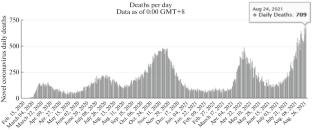改进以混合 SIR 模型形式模拟 SAR-CoV-2 演变的方法,以预测新的 COVID-19 浪潮
摘要
摘要 讨论了对 2024 年由于新的 SAR-CoV-2 分支和 Pirola 浪潮而恢复的流行过程进行计算研究的方法。将基于各种分区 SIR 系统的流行病建模技术与根据个体流行病状态之间的转换方案进行反射的流行病建模技术进行了比较,并对迅速出现的更新冠状病毒传播的皮罗拉浪潮进行了分析。在 SIR 系统中加入二阶非线性方程的物理振荡器被认为是修改流行病模型的一种方法,但其复杂的模式和随机性并不符合流行病的进程。为了模拟因病毒演变而出现脉动变化的生物物理过程的非线性效应趋势的变化,采用了基于修改技术物理模型(如 Korteweg-de Vries 方程)的方法。模型的计算实验结果不能被视为充分的结果。计算的一致性没有得到证明。作者建议将与 COVID 有关的结构扩展到 12 个状态。结果表明,在描述 COVID 特征的种群成员状态之间转换的微分方程 SIR 系统中,扩展一组可能的状态不会导致出现被新疫情打断的阻尼振荡模式。在预测新感染传播的领域,并非所有因素都能在短期内确定。经典的流行病模型,即使从根本上扩展了线性 SIR 框架,也不适合 COVID 感染链的非线性和脉冲生成方面,除非它们包括感染和免疫阈值以及滞后因子。事实证明,扩展 SIR 系统的方法不具有预测前景。研究表明,2021 年出现的 Omicron BA 菌株新分支和 2023 年出现的 JN 菌株新分支导致了振荡形状的质变,而不仅仅是峰值振幅的质变。峰值与最小值之间的间隔时间增加了,也就是说,并非只有一个 SIR 模型参数发生了变化。根据我们的数据分析,在 2024 年的冬季和春季,大流行期间的感染病例将过渡到第三种振荡模式。一些国家在 2023 年春季完全取消了防疫限制措施,这使我们能够根据 2024 年新的疫情波形,分析口罩任务和封锁因素的影响。经证实,这些严格措施并没有改变传染率超过临界阈值的疫情形势。根据螺旋原理,考虑到冠状病毒的脉冲演化,提出了基于混合预测重定义方程组的疫情模型发展方案。对于振荡流行模式的形式转换,使用了带有临界调节延迟和阻尼器的预测性重新定义方程。


Methods for computational study of the epidemic process resumed in 2024 due to the new SAR-CoV-2 branch and the Pirola wave are discussed. The epidemic modeling technique based on various compartmental SIR systems with the reflection of transitions according to the scheme between the epidemic statuses of individuals is compared with the analysis of the rapidly emerging Pirola wave of the spreading updated coronavirus. The inclusion of physical oscillators of second-order nonlinear equations into a SIR system has been considered a way to modify the epidemic models, but their complex modes and randomization do not correspond to the epidemic course. To simulate changes in the trends in nonlinear effects of the biophysical processes experiencing pulsating variations caused by the evolution of the virus, approaches based on modification of the technical physics models, e.g., the Korteweg‒de Vries equation, have been used. The results of the computational experiments with the model cannot be considered as a sufficient result. The consistency of the computations has not been justified. The author has proposed to expand the structure to 12 statuses in relation to COVID. It is shown that expanding a set of possible statuses in a SIR system of differential equations that describe transitions between statuses of population members characteristic of COVID does not lead to the appearance of damped oscillatory modes interrupted by a new outbreak. In the field of forecasting the spread of new infections, not all factors will be established in the near future. Classical epidemic models, even with a fundamental extension of the linear SIR framework, are not suitable for the aspects of nonlinearity and pulse generation of COVID infection chains unless they include infected and immune thresholds and a lag factor. It has been substantiated that the method for expanding SIR systems does not have prognostic prospects. It is shown that the emergence of new branches of the Omicron BA strains in 2021 and JN in 2023 led to the qualitative transformation of the shape of oscillations and not just the peak amplitude. The interval between a peak and minimum has increased, i.e., not only one of the SIR model parameters has changed. According to the analysis of our data, in the winter and spring of 2024, the transition to the third mode of oscillations of infection cases during the pandemic period is implemented. In several countries, antiepidemic restrictions were completely removed in the spring of 2023, which allowed us, based on the course of new waves in 2024, to analyze the effect of the mask mandate and lockdown factors. It has been confirmed that these strict measures did not change the epidemic situation, in which the transmissibility rate exceeds a critical threshold value. A scenario for the development of the epidemic models based on hybrid predicatively redefined systems of equations is proposed, which takes into account the pulsed evolution of the coronavirus according to the spiral principle. For transitions of forms of oscillatory epidemic modes, a predicative redefinition of equations with the threshold regulation delay and dampers has been used.

 求助内容:
求助内容: 应助结果提醒方式:
应助结果提醒方式:


